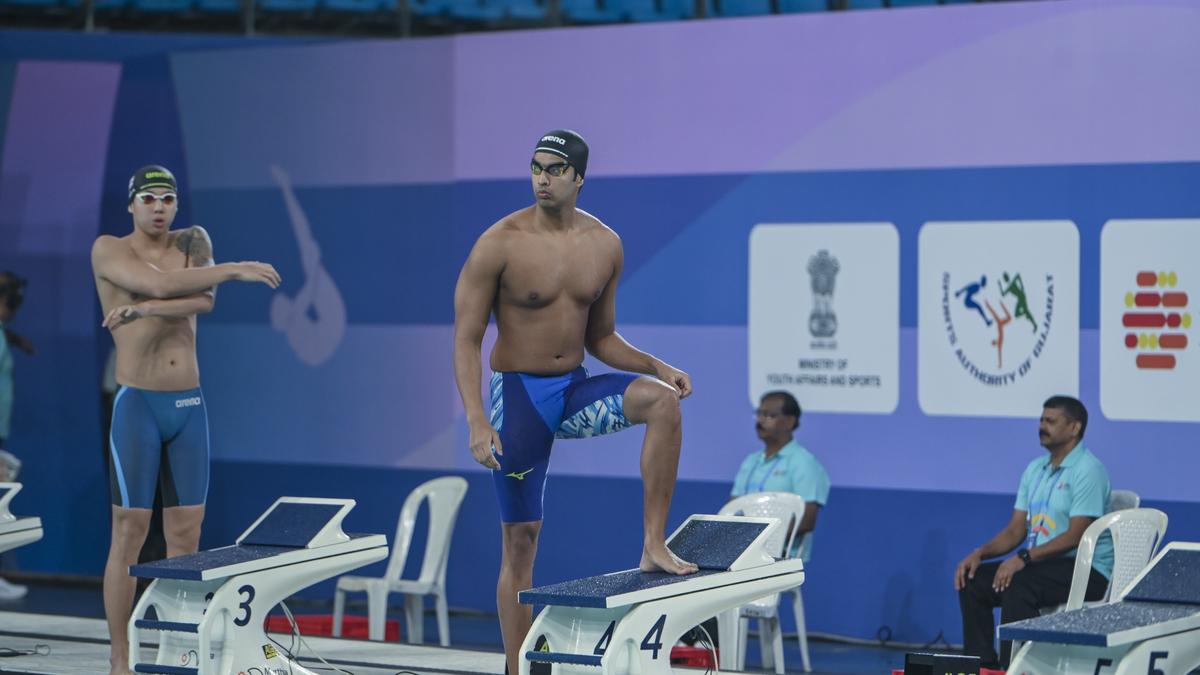Srihari Nataraj Interview – Karate Kid: Legends and use of data behind seven Asian Championships medals
Srihari Nataraj caused a ripple effect as he clinched a silver medal in the men’s 200m freestyle event on the opening day of the 11th Asian Aquatics Championships, held at the Veer Savarkar Sports Complex in Naranpura, Gujarat, from September 28 to October 10.
It was India’s first medal at the continental event in 16 years. The host nation eventually finished with its best-ever haul of 13 medals in a single edition — four silver and nine bronze — and the 24-year-old from Bengaluru played a huge role in that success, with four individual medals and three in relays.
In an exclusive conversation with Sportstar, Srihari opened up about his preparation, the use of data to improve his results, and more:
Did you know before this event that India hadn’t won a medal for 16 years?
I knew we didn’t win a medal at the previous one in 2016. I did the qualifying time (during the trials), but I came third. Then, one of my seniors, who came second, said he wasn’t going to swim the 200m backstroke. He said he’d inform the federation so that I’d get the spot, but I didn’t. I didn’t know it had been 16 years — it wasn’t on my mind.
How did you prepare for the event?
It was a good month in Ahmedabad under coach Nihar Ameen. I like to stay at home and train, but we had the camp. The facility was really good.
I did miss some of Mum’s food and the way she pampers me before sessions with a milkshake. She even jokingly told someone that maybe the difference between gold and silver in some of the events was the smoothies and the stuff she keeps ready for me before or after my sessions.
Out of the seven medals you won, which one was the toughest, and in which did you feel you had the best chance of winning gold?
If I had swum just the 50m backstroke, it would have been a lot closer than it was. That was definitely an event where I thought I could get gold. [The gap between Srihari and China’s Gukailai Wang, the gold medallist, was 0.35 seconds)
Going into the 100m backstroke final, I was the fastest seed, and I hadn’t swum the 100m backstroke for a medal this entire year, or even in a final. I thought I might surprise myself — and at 75m, I did surprise myself — but physically, that was a tough race for me.
How did data analytics help you in your training and races?
I’ve been working with Swimple, a company that analyses races, for a long time. It’s based at the Padukone–Dravid Centre for Sports Excellence, where I train.
The guy (Aditya Kariyappa) who set it up was initially working in Eindhoven with the Dutch national team. Two years ago, I took a trip to Eindhoven to get my assessments done. They give you every bit of data — stroke rate, distance per stroke, velocity, stroke length, turn time, underwater distance — to find the most optimal way to swim.
Sometimes, you swim at a high stroke rate, thinking the faster you pull, the faster you’ll swim, but that’s not true, because sometimes you’re just putting in energy to pull faster without catching any water. And if you don’t, you’re just slipping, wasting energy, and staying in the same place. They have a camera system and delayed feedback. When you swim, you have the whole system with the metrics, and then you get the feedback 30 seconds or a minute later. You can see what’s happening with your stroke. Technically, the coach and the analyst are there to tell you what’s good and what’s not, and you can immediately make changes.
Then, you get metrics to see whether those changes are working positively or negatively. That’s something you incorporate into training every day. This is how the Europeans have been training for a long time — and the Australians as well, in some places. Sometimes, textbook-wise, your technique might be right, but you might not actually need it — and until you have the metrics, you don’t know.
Any recent example where Swimple helped you?
I went to the Singapore Open earlier this year. It was pretty much my first tournament of the season after the National Games. I wanted to get some races in before the World University Games.
I swam the 100m freestyle heats and felt the stroke rate was a bit conserved. In the evening, I tried pushing a little more, but we realised that more effort for me doesn’t mean it’s more optimal. I actually swam slower, and we understood why. Going into the 200m freestyle, we kept it optimal. We knew the exact stroke rate I should swim at. Going into the 200m finals, they noticed that in my third turn, I was slowing down going into the wall — I needed to carry more momentum and use that for my underwaters. These small changes made a 0.1–0.2-second difference per lap, which adds up in the end.
Besides swimming, you also love watching films. Did you watch any during the tournament?
Karate Kid Legends before the 200m freestyle finals. I swam the heats and it was bad. I was overthinking a bit when I came back to my room. I told my roommate, and we played it on the TV at the hotel. During the month-long camp, I must’ve watched at least 15 films.
Srihari Nataraj’s medals at Asian Aquatics Championships 2025:
Men’s 50m Backstroke – Silver
Men’s 200m Freestyle – Silver
Men’s 4x200m Freestyle Relay – Silver
Men’s 100m Freestyle – Bronze
Men’s 100m Backstroke – Bronze
Men’s 4x100m Freestyle Relay – Bronze
Men’s 4x100m Medley Relay – Bronze
Published on Oct 23, 2025


